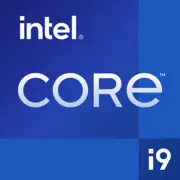Intel Core i9-11900F

Intel Core i9-11900F: In-Depth Analysis of the Processor for Demanding Tasks
April 2025
1. Key Specifications: Rocket Lake Architecture and Performance
The Intel Core i9-11900F processor, released in 2021, remains a relevant solution for a range of tasks due to its unique architecture.
Architecture and Process Technology
- Codename: Rocket Lake-S.
- Process Technology: 14 nm (Intel SuperFin). Despite the age of the technology, Intel has optimized the process, reducing power consumption and increasing frequencies.
- Cores and Threads: 8 cores, 16 threads.
- Frequencies: Base frequency — 2.5 GHz, maximum turbo frequency — 5.2 GHz (Thermal Velocity Boost).
- Cache: 16 MB L3.
- TDP: 65 W (actual power consumption under load can reach 150 W).
Key Features:
- Support for PCIe 4.0 (20 lanes) for fast NVMe storage and graphics cards.
- Integration of AI acceleration technology (Intel DL Boost) for machine learning tasks.
- Implementation of Adaptive Boost technology for automatic frequency increase in multi-threaded scenarios.
Performance:
- Geekbench 6: 2188 (single-core), 10129 (multi-core). This is comparable to modern mid-range processors, such as the AMD Ryzen 5 7600X (2300/10500).
- In gaming (Cyberpunk 2077, 1080p Ultra), the i9-11900F demonstrates 150–180 FPS paired with the RTX 4070, but lags behind newer CPUs in 4K rendering.
2. Compatible Motherboards: LGA 1200 Socket and Chipsets
The i9-11900F requires a motherboard with an LGA 1200 socket. Supported chipsets:
- Z590: Best choice for overclocking (e.g., ASUS ROG Strix Z590-E, ~$250 in 2025). Support for PCIe 4.0, RAM overclocking up to 5333 MHz.
- B560: Budget option with limited overclocking (MSI B560 Tomahawk, ~$150). Support for XMP profiles for memory.
- H570/H510: For office builds. No CPU overclocking, limited ports available.
Tip: Choose motherboards with a robust VRM module (e.g., 12+1 phases) for stable performance under load.
3. Supported Memory: DDR4 and Its Potential
The i9-11900F works only with DDR4 (up to 3200 MHz in standard mode). With XMP, it can be overclocked to 4000–4400 MHz.
Recommendations:
- Optimal option: 32 GB (2×16 GB) DDR4-3600 CL16 (e.g., G.Skill Trident Z Neo, ~$120).
- For gaming, 16 GB is sufficient, but for rendering, 32 GB is better.
Limitation: The lack of support for DDR5 makes the processor less future-proof.
4. Power Supplies: Power Calculation
With a TDP of 65 W, actual consumption under load can reach 150 W.
Recommendations:
- Minimum: 650 W (for systems with RTX 4070 or similar GPUs).
- Ideal: 750–850 W with 80 Plus Gold certification (Corsair RM750x, ~$130).
- Important: Use an 8-pin CPU cable and avoid cheap power supplies without overload protection.
5. Pros and Cons
Pros:
- High single-threaded performance (relevant for gaming and Adobe Photoshop).
- Support for PCIe 4.0 for fast SSDs.
- Low TDP in base mode (energy efficiency in office tasks).
Cons:
- 14 nm process technology versus 5–7 nm competitors (higher heat under load).
- No DDR5 and PCIe 5.0 support.
- Price: ~$300 (as of April 2025) — for this money, one can buy a more modern i5-13600K.
6. Use Cases
- Gaming: Ideal for 1080p/1440p with high FPS (Valorant, CS2). In 4K, it is limited by the GPU.
- Work Tasks: Video editing in Premiere Pro (8 cores are sufficient for medium-complexity projects), but rendering in Blender is slower than with the Ryzen 9 7900X.
- Multimedia: Streaming (OBS + NVENC) without lags.
Example: Streamers report smooth performance when encoding 1080p60 with effects applied.
7. Comparison with Competitors
- AMD Ryzen 7 5800X: Costs ~$280. Better in multi-threaded tasks (Cinebench R23: 15000 vs. 12000 for i9), but worse in single-threaded performance.
- Intel Core i5-13600K: For $320 offers 14 cores (6P+8E), DDR5, and PCIe 5.0 support.
- Conclusion: The i9-11900F only excels in scenarios where high frequency is more critical than multi-threading.
8. Practical Assembly Tips
1. Cooling: Use an AIO (e.g., NZXT Kraken X63) or a powerful tower cooler (Noctua NH-D15).
2. Case: Minimum of 2 intake fans and 1 exhaust fan.
3. Storage: Samsung 980 Pro (PCIe 4.0) for maximum speed.
4. Graphics Card: RTX 4070 or RX 7700 XT — a balanced setup without bottlenecks.
Common Beginner Mistake: Installing a weak cooler can lead to throttling under prolonged load.
9. Final Conclusion: Who Should Consider the i9-11900F?
This processor is worth considering if:
- You need a powerful CPU for 1080p/1440p gaming at an affordable price.
- You require an upgrade of an old LGA 1200 system without replacing the motherboard.
- PCIe 4.0 and high frequency are more important than DDR5 support.
Alternative: For new builds, it is better to choose the i5-13600K or Ryzen 7 7700X.
Price in April 2025: ~$300 (new, with warranty). Despite its age, the i9-11900F remains a niche solution for those valuing proven reliability over following trends.
Basic
CPU Specifications
Memory Specifications
GPU Specifications
Miscellaneous
Benchmarks
Compared to Other CPU
Share in social media
Or Link To Us
<a href="https://cputronic.com/en/cpu/intel-core-i9-11900f" target="_blank">Intel Core i9-11900F</a>